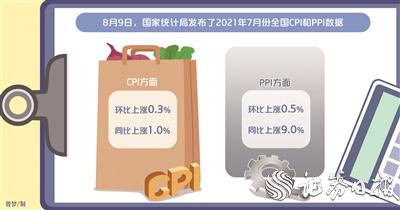The year-on-year increase in CPI has fallen for two consecutive months, with a high probability of maintaining a moderate trend during the year
Our reporter Su Shiyu
On August 9, the National Bureau of Statistics released the national CPI (Consumer Price Index) and PPI (Ex-factory Price Index of Industrial Producers) data for July 2021.
Many people in the industry believe that the PPI and CPI scissors gap has widened again, but the inflationary pressure is generally controllable.
Judging from specific data, in July, all regions and departments coordinated efforts in epidemic prevention and control, flood prevention and disaster relief, and economic and social development, and actively implemented the policy of ensuring supply and stabilizing prices, and market supply and demand were generally stable.
In terms of CPI, the month-on-month decrease of 0.4% in June turned to an increase of 0.3%; the year-on-year increase was 1.0%, and the increase was 0.1 percentage point lower than that in June.
In terms of PPI, in July, the price increase of industrial products increased slightly due to the sharp increase in the prices of crude oil, coal and related products.
PPI rose 0.5% month-on-month, an increase of 0.2 percentage points over June; it was up 9.0% year-on-year, and the increase was 0.2 percentage points higher than that in June.
In this regard, Li Chao, chief economist of Zheshang Securities, said that the PPI rose by 9.0% year-on-year in July. The upstream raw material varieties rose more or less, coal prices continued to rise, and the PPI returned to its previous high.
The CPI rose by 1.0% year-on-year, and it fell for two consecutive months. The food item has been a major drag, and the core CPI has maintained a recovery trend.
The scissors gap between PPI and CPI has widened again, cost transmission from upstream to downstream is still not smooth, and mid- and downstream enterprises are under greater operating pressure.
Wen Bin, chief researcher of China Minsheng Bank, told reporters that from the data point of view, the transmission of PPI to CPI is not smooth.
The scissors gap between PPI and CPI in July reached 8 percentage points, a new high since the data, indicating that the transmission of price increases from upstream to downstream is not smooth.
The core CPI rose by 1.3% year-on-year, setting a new high since February 2020. The increase was 0.4 percentage points higher than the previous month, indicating that prices have risen excluding food and energy, especially the price of services rose by 1.6% year-on-year, a record increase in 2019. New high since September.
Fan Ruoying, a researcher at the Bank of China Research Institute, told the "Securities Daily" reporter that the unsynchronized prices of upstream, midstream and downstream products affect the profit growth of different industries.
On the one hand, the rising prices of raw materials industry promoted the leading profit growth rate in the upstream industry; on the other hand, the bargaining power of enterprises in the middle and downstream industries is weak, and the prices of terminal consumer products cannot rise simultaneously with the prices of raw materials, and enterprises are forced to bear the pressure of rising costs.
"It is expected that the increase of PPI in August will remain high, and the increase of CPI will continue to fall." Fan Ruoying said that PPI will continue to operate at a high level, and the increase may converge. The effect of the supply stabilization policy will be further manifested, and the Fed's monetary policy will shift to the expected warming; second, the PPI carryover factor will become smaller.
In terms of CPI, the growth rate will fall further: first, the decline in pork prices will still be the main drag on CPI, the current stock of reproductive sows is still at a high level, and pork prices will remain low in the future; second, the impact of CPI tail-lifting factors will weaken, 8 The month drops to 0.
Wen Bin said that as a whole, commodity prices slowed down or peaked and fell, PPI is expected to maintain a trend of volatility and decline; pork and other food prices may continue to decline, CPI is likely to maintain a moderate trend during the year, and the level of inflation is generally controllable. , The overall impact on monetary policy is limited.
Macroeconomic policies should be well adjusted across cycles, maintain reasonable and sufficient liquidity, continue to do a good job in ensuring the supply and price stability of bulk commodities, and help small and medium-sized enterprises and difficult industries alleviate the impact of rising raw material prices on production and operations.
(Securities Daily)

